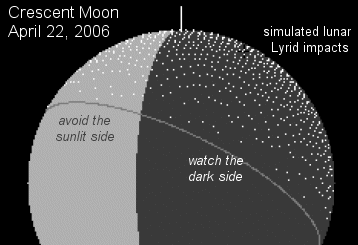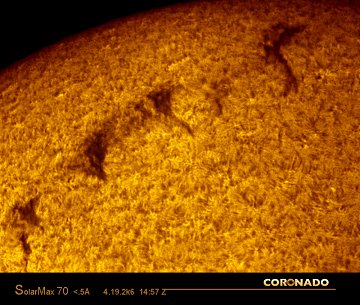 Did you sleep through the auroras of April? Next time get a wake-up call. Sign up for Spaceweather PHONE.
Did you sleep through the auroras of April? Next time get a wake-up call. Sign up for Spaceweather PHONE.
METEOR ALERT: Earth is about to skirt the dusty tail of Comet Thatcher (C/1861 G1), and this will cause the annual Lyrid meteor shower. Forecasters expect the shower to peak on April 22nd, producing about 10 meteors per hour--modest, but pretty. The best time to look is during the hours before dawn on Saturday morning. Go to a dark site away from city lights, if possible. [full story]
The Moon will also encounter the comet's tail on April 22nd, which raises an interesting possibility: Amateur astronomers may be able to see flashes of light on the Moon when comet debris hits the lunar surface and explodes. All that's required is a backyard telescope and lots of patience.

Simulated lunar Lyrid impacts. Image credit: Pete Gural, SAIC.
Want to try? Train your telescope on the dark side of the Moon, which rises around 3 a.m. on Saturday: sky map. Lyrids will be raining down on the northern third of the visible disk. In the eyepiece, watch for fleeting, point-like flashes. Better yet, let a video camera do the watching for you. Brian Cudnik, who coordinates amateur observations of lunar impacts for the Association of Lunar and Planetary Observers, explains how.
SUN SERPENT: Yesterday, astrophotographer Gary Palmer of Los Angeles, California, claims to have spotted the Loch Ness Monster--on the Sun. You decide:

This fluffy solar filament does indeed resemble a sea serpent. In a few days, though, it'll look like something utterly different. The sun's rotation is carrying the filament toward the sun's limb. Soon, it will hang out over the edge, blazing bright against the black space beyond, transforming a dark serpent into a hot glowing ... what? Stay tuned!
more images: from Mike Taormina of Palatine, Illinois;

